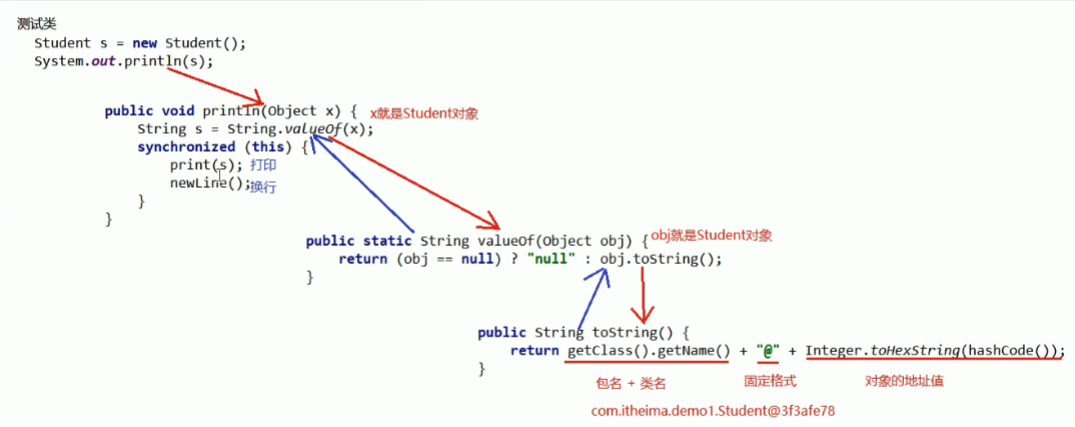常用api --- Math System Object Objects
2.1 Math(应用)
-
1、Math类概述
-
Math 包含执行基本数字运算的方法
-
-
2、Math中方法的调用方式
-
Math类中无构造方法,但内部的方法都是静态的,则可以通过 类名.进行调用
-
-
3、Math类的常用方法
方法名 方法名 说明 public static int abs(int a) 返回参数的绝对值 public static double ceil(double a) 返回大于或等于参数的最小double值,等于一个整数 public static double floor(double a) 返回小于或等于参数的最大double值,等于一个整数 public static int round(float a) 按照四舍五入返回最接近参数的int public static int max(int a,int b) 返回两个int值中的较大值 public static int min(int a,int b) 返回两个int值中的较小值 public static double pow (double a,double b) 返回a的b次幂的值 public static double random() 返回值为double的正值,[0.0,1.0)

package test; import java.util.ArrayList; public class Mxxl { public static void main(String[] args) { // public static int abs(int a); //返回参数的绝对值 int abs = Math.abs(10); System.out.println(abs); // public static double ceil(double a) 向上取整 // double ceil = Math.ceil(10.1); // System.out.println(ceil); // public static double floor(double a) 向下取整 // double floor = Math.floor(10.9); // System.out.println(floor); // public static int round(float a) 四舍五入 // long round = Math.round(10.1); // System.out.println(round); // // long round1 = Math.round(1.9); // System.out.println(round1); // public static int max(int a,int b) 返回两个int值中的较大值 // int max = Math.max(10, 20); // System.out.println(max); // public static int min(int a,int b) 返回两个int值中的较小值 // int min = Math.min(10, 20); // System.out.println(min); // public static double pow(double a,double b)返回a的b次幂的值 // double pow = Math.pow(2, 3); // System.out.println(pow); // public static double random() 返回值为double的正值,[0.0,1.0) for (int i = 0; i < 10 ; i++) { double random = Math.random(); System.out.println(random); } } }
2.2 System(应用)
-
System类的常用方法
方法名 说明 public static void exit(int status) 终止当前运行的 Java 虚拟机,非零表示异常终止 public static long currentTimeMillis() 返回当前时间(以毫秒为单位) -
示例代码
-
需求:在控制台输出1-10000,计算这段代码执行了多少毫秒
public class SystemDemo {
public static void main(String[] args) {
// 获取开始的时间节点
long start = System.currentTimeMillis();
for (int i = 1; i <= 10000; i++) {
System.out.println(i);
}
// 获取代码运行结束后的时间节点
long end = System.currentTimeMillis();
System.out.println("共耗时:" + (end - start) + "毫秒");
}
} -

public class SystemDemo { public static void main(String[] args) { // public static void exit(int status) 终止当前运行的 Java 虚拟机,非零表示异常终止 // System.out.println(111); // //while(true){} // System.exit(0); //当代码执行到这个方法的时候,就表示虚拟机已经停止了 // System.out.println(2222); // public static long currentTimeMillis() 返回当前时间(以毫秒为单位) // long start = System.currentTimeMillis();//获取当前时间 // //System.out.println(l); // for (int i = 0; i < 10000; i++) { // System.out.println(i); // } // long end = System.currentTimeMillis();//获取当前时间 // System.out.println(end - start);//472 --- 得到的就是这个for循环运行的时间. // arraycopy(数据源数组, 起始索引, 目的地数组, 起始索引, 拷贝个数) 数组copy int [] arr1 = {1,2,3,4,5}; int [] arr2 = new int[10]; //需求:我要把arr1中的数据拷贝到arr2中. //System.arraycopy(arr1,0,arr2,0,arr1.length); /*for (int i = 0; i < arr2.length; i++) { System.out.println(arr2[i]); }*/ //我要把arr1最后两个元素,拷贝到arr2的最后两个索引上 System.arraycopy(arr1,3,arr2,8,2); for (int i = 0; i < arr2.length; i++) { System.out.println(arr2[i]); } } }
2.3 Object类的toString方法(应用)
-
Object类概述
-
Object 是类层次结构的根,每个类都可以将 Object 作为超类。所有类都直接或者间接的继承自该类,换句话说,该类所具备的方法,所有类都会有一份
-
-
查看方法源码的方式
-
选中方法,按下Ctrl + B
-
-
重写toString方法的方式
-
Alt + Insert 选择toString
-
-
在类的空白区域,右键 -> Generate -> 选择toString
-
-
toString方法的作用:
-
以良好的格式,更方便的展示对象中的属性值
-
-
示例代码:
class Student extends Object {
private String name;
private int age;
public Student() {
}
public Student(String name, int age) {
this.name = name;
this.age = age;
}
public String getName() {
return name;
}
public void setName(String name) {
this.name = name;
}
public int getAge() {
return age;
}
public void setAge(int age) {
this.age = age;
}
-
运行结果:
Student{name='林青霞', age=30}
Student{name='林青霞', age=30}

2.4 Object类的equals方法(应用)
-
equals方法的作用
-
用于对象之间的比较,返回true和false的结果
-
举例:s1.equals(s2); s1和s2是两个对象
-
-
重写equals方法的场景
-
不希望比较对象的地址值,想要结合对象属性进行比较的时候。
-
-
重写equals方法的方式
-
alt + insert 选择equals() and hashCode(),IntelliJ Default,一路next,finish即可
-
-
在类的空白区域,右键 -> Generate -> 选择equals() and hashCode(),后面的同上。
-
-
示例代码:
class Student {
private String name;
private int age;
public Student() {
}
public Student(String name, int age) {
this.name = name;
this.age = age;
}
public String getName() {
return name;
}
public void setName(String name) {
this.name = name;
}
public int getAge() {
return age;
}
public void setAge(int age) {
this.age = age;
}
-
面试题
// 看程序,分析结果
String s = “abc”;
StringBuilder sb = new StringBuilder(“abc”);
s.equals(sb);
sb.equals(s);
public class InterviewTest {
public static void main(String[] args) {
String s1 = "abc";
StringBuilder sb = new StringBuilder("abc");
//1.此时调用的是String类中的equals方法.
//保证参数也是字符串,否则不会比较属性值而直接返回false
//System.out.println(s1.equals(sb)); // false
//StringBuilder类中是没有重写equals方法,用的就是Object类中的.
System.out.println(sb.equals(s1)); // false
}
}
2.5 Objects (应用)
-
方法名 说明 public static String toString(对象) 返回参数中对象的字符串表示形式。 public static String toString(对象, 默认字符串) 返回对象的字符串表示形式。 public static Boolean isNull(对象) 判断对象是否为空 public static Boolean nonNull(对象) 判断对象是否不为空 -
示例代码
学生类
class Student {
private String name;
private int age;
public Student() {
}
public Student(String name, int age) {
this.name = name;
this.age = age;
}
public String getName() {
return name;
}
public void setName(String name) {
this.name = name;
}
public int getAge() {
return age;
}
public void setAge(int age) {
this.age = age;
}
测试类
public class MyObjectsDemo {
public static void main(String[] args) {
// public static String toString(对象): 返回参数中对象的字符串表示形式。
// Student s = new Student("小罗同学",50);
// String result = Objects.toString(s);
// System.out.println(result);
// System.out.println(s);
// public static String toString(对象, 默认字符串): 返回对象的字符串表示形式。如果对象为空,那么返回第二个参数.
//Student s = new Student("小花同学",23);
// Student s = null;
// String result = Objects.toString(s, "随便写一个");
// System.out.println(result);
// public static Boolean isNull(对象): 判断对象是否为空
//Student s = null;
// Student s = new Student();
// boolean result = Objects.isNull(s);
// System.out.println(result);
// public static Boolean nonNull(对象): 判断对象是否不为空
//Student s = new Student();
Student s = null;
boolean result = Objects.nonNull(s);
System.out.println(result);
}
}


